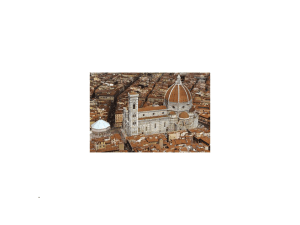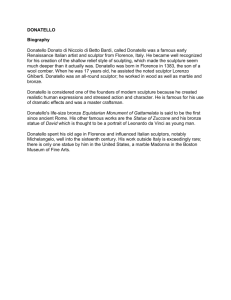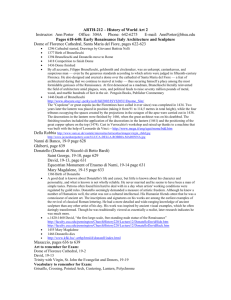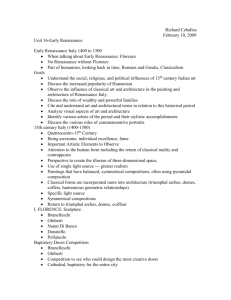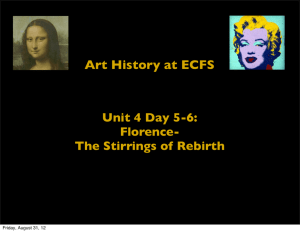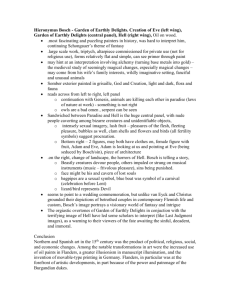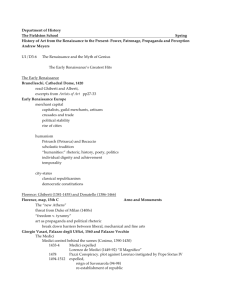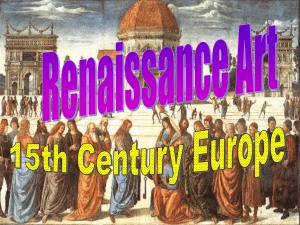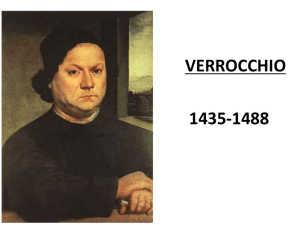chp 12-early ren
advertisement
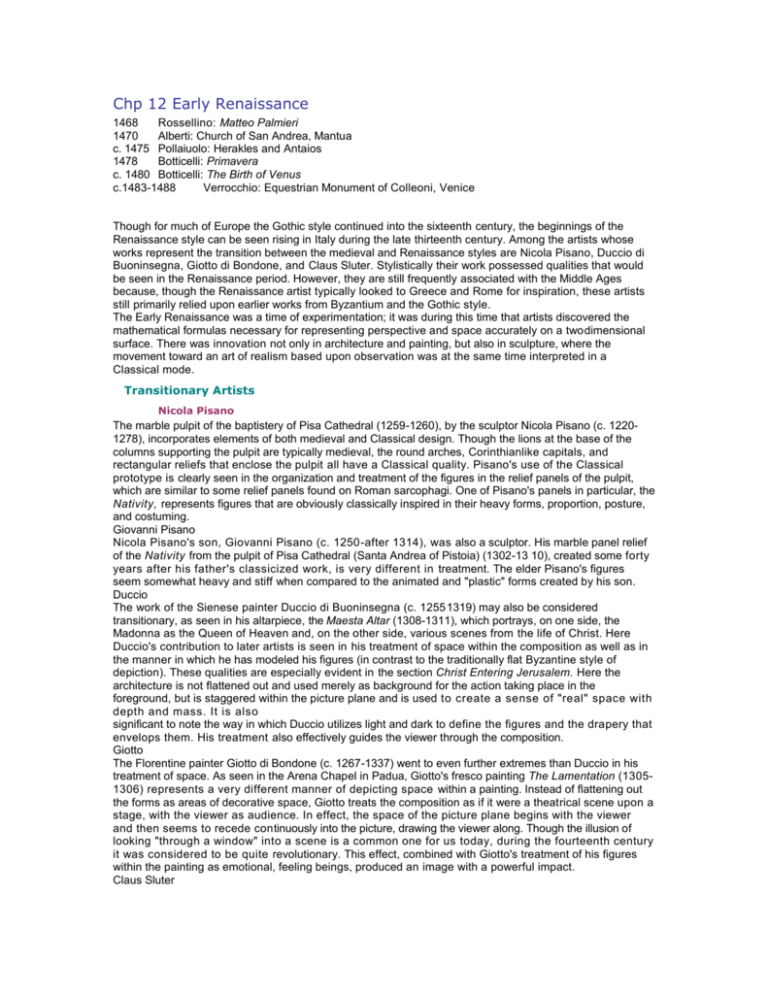
Chp 12 Early Renaissance 1468 Rossellino: Matteo Palmieri 1470 Alberti: Church of San Andrea, Mantua c. 1475 Pollaiuolo: Herakles and Antaios 1478 Botticelli: Primavera c. 1480 Botticelli: The Birth of Venus c.1483-1488 Verrocchio: Equestrian Monument of Colleoni, Venice Though for much of Europe the Gothic style continued into the sixteenth century, the beginnings of the Renaissance style can be seen rising in Italy during the late thirteenth century. Among the artists whose works represent the transition between the medieval and Renaissance styles are Nicola Pisano, Duccio di Buoninsegna, Giotto di Bondone, and Claus Sluter. Stylistically their work possessed qualities that would be seen in the Renaissance period. However, they are still frequently associated with the Middle Ages because, though the Renaissance artist typically looked to Greece and Rome for inspiration, these artists still primarily relied upon earlier works from Byzantium and the Gothic style. The Early Renaissance was a time of experimentation; it was during this time that artists discovered the mathematical formulas necessary for representing perspective and space accurately on a twodimensional surface. There was innovation not only in architecture and painting, but also in sculpture, where the movement toward an art of realism based upon observation was at the same time interpreted in a Classical mode. Transitionary Artists Nicola Pisano The marble pulpit of the baptistery of Pisa Cathedral (1259-1260), by the sculptor Nicola Pisano (c. 12201278), incorporates elements of both medieval and Classical design. Though the lions at the base of the columns supporting the pulpit are typically medieval, the round arches, Corinthianlike capitals, and rectangular reliefs that enclose the pulpit all have a Classical quality. Pisano's use of the Classical prototype is clearly seen in the organization and treatment of the figures in the relief panels of the pulpit, which are similar to some relief panels found on Roman sarcophagi. One of Pisano's panels in particular, the Nativity, represents figures that are obviously classically inspired in their heavy forms, proportion, posture, and costuming. Giovanni Pisano Nicola Pisano's son, Giovanni Pisano (c. 1250-after 1314), was also a sculptor. His marble panel relief of the Nativity from the pulpit of Pisa Cathedral (Santa Andrea of Pistoia) (1302-13 10), created some forty years after his father's classicized work, is very different in treatment. The elder Pisano's figures seem somewhat heavy and stiff when compared to the animated and "plastic" forms created by his son. Duccio The work of the Sienese painter Duccio di Buoninsegna (c. 12551319) may also be considered transitionary, as seen in his altarpiece, the Maesta Altar (1308-1311), which portrays, on one side, the Madonna as the Queen of Heaven and, on the other side, various scenes from the life of Christ. Here Duccio's contribution to later artists is seen in his treatment of space within the composition as well as in the manner in which he has modeled his figures (in contrast to the traditionally flat Byzantine style of depiction). These qualities are especially evident in the section Christ Entering Jerusalem. Here the architecture is not flattened out and used merely as background for the action taking place in the foreground, but is staggered within the picture plane and is used to create a sense of "real" space with depth and mass. It is also significant to note the way in which Duccio utilizes light and dark to define the figures and the drapery that envelops them. His treatment also effectively guides the viewer through the composition. Giotto The Florentine painter Giotto di Bondone (c. 1267-1337) went to even further extremes than Duccio in his treatment of space. As seen in the Arena Chapel in Padua, Giotto's fresco painting The Lamentation (13051306) represents a very different manner of depicting space within a painting. Instead of flattening out the forms as areas of decorative space, Giotto treats the composition as if it were a theatrical scene upon a stage, with the viewer as audience. In effect, the space of the picture plane begins with the viewer and then seems to recede continuously into the picture, drawing the viewer along. Though the illusion of looking "through a window" into a scene is a common one for us today, during the fourteenth century it was considered to be quite revolutionary. This effect, combined with Giotto's treatment of his figures within the painting as emotional, feeling beings, produced an image with a powerful impact. Claus Sluter Claus Sluter (1380-1406), a Dutch sculptor who practiced his craft in France during the last decade or so of the fourteenth century, is perhaps best known for his high-relief sculpture known as The Moses Well (1395-1406). The sculptural pedestal has six sides, and emerging from each panel is a life-size prophet from the Old Testament. What is striking about these figures is the individuality of personality that is portrayed in each. Though the figures themselves lack the rigidity typical of the style of the Middle Ages, this quality is still seen in the heavy treatment of the drapery and fabric that envelop them. The Artist's Knowledge of the Visual World Whereas artists during the Middle Ages had relied upon established archetypal images as sources for their depiction of the human figure, the Renaissance artist, living in an era that allowed for humankind to examine itself and its surroundings, slowly began to shift this visual attention to the natural world. By the fifteenth century, it was an accepted practice to utilize nature as a source for one's artistic production; by the sixteenth century, concise theories encompassing the naturalistic representation of the human figure and the visual world were established. These changes in the core values concerning the manner in which art was produced paralleled changes in thought concerning how humankind was to know its world. Instead of the traditional modes of thought typical of the Middle Ages, in which people were to come to know God and the world through philosophy and reason, the people of the Renaissance came to rely on direct human experience for their knowledge. This approach supported the notion of experimentation that emerged with the scientific method of investigating natural phenomena. The Fifteenth Century in Florence Many historians consider Florence to have been the source of the Renaissance, which commenced at the beginning of the fifteenth century. Florence was then governed by wealthy families from the merchant class, including the Albizzi, Capponi, Medici, Pazzi, and Strozzi. By the 1430s, however, it was the Medici family that ruled the city, though not by title. The Medici were also great patrons of the arts and literature. Relief Sculpture: The Baptistery Doors Competition Representative of the new artistic era of Florence was a competition held in 1401 for the design of the north doors of the Baptistery of Florence, which was built in the eleventh century. The south doors of the Baptistery, cast in bronze, had been designed by Andrea Pisano and were Gothic in style. Six artists were selected from those who entered the competition, and they were given one year to design and produce a panel cast in bronze depicting the Old Testament story of the sacrifice of Isaac. At the end of the year, the works of the artists were judged, and the field was narrowed down to the work of two young artists: Filippo Brunelleschi (1377-1446) and Lorenzo Ghiberti (c. 1381-1455). As it happened, their entries to the competition also were the least conservative and traditional of the works submitted. Brunelleschi's Entry Brunelleschi's entry depicted the exact instant Abraham's thrust of the knife toward his son Isaac's throat was stopped by an angel of the Lord. Brunelleschi's placement of the figures within the panel seemed to be in response to the four-lobed (quatrefoil) form of the panel itself, with the angel on the left, Abraham on the right, and Isaac in the middle-a fairly symmetrical composition. The stances of the figures as well as the sweeping drapery that enveloped them appeared to reflect the shape of the panel. Ghiberti's Entry The panel that Ghiberti submitted-and for which he won the prize-portrayed Abraham and Isaac at a moment in time when Abraham was about to thrust the knife into his son's throat. His placement of the figures within the panel was asymmetrical, with the focus of attention upon Abraham in the middle and Isaac on the right. Ghiberti's treatment of the figure of Isaac reveals, in part, the direction the Renaissance was to flow. His Isaac was obviously based upon earlier Classical works, as reflected in the figure's musculature and wellproportioned form; the panel reflects both a sense of realism and the quality of idealized beauty. Ghiberti's design for the doors followed the format established by Pisano on the south doors, with the space divided up into twenty-eight quatrefoils, each representing a figure or a biblical scene. As in his prize-winning panel, Ghiberti's style as seen in his treatment of the figures and his use of space represented a shift from Gothic idealism to naturalism. Ghiberti's Gates of Paradise Soon after Ghiberti's doors were completed and installed, he was offered the opportunity to create yet another set of doors, this time for the eastern side of the baptistery facing the cathedral. These doors took twenty-five years to complete and were finally set in place in 1452. His design for these doors changed somewhat from the earlier ones, as seen, for example, in the manner in which he reduced the number of panels from twenty-eight to ten and used the same figural proportion throughout, so that the foreground figures were all the same size. His treatment of space, perspective, and the figure suggests his continued study of nature. These doors so impressed the artist Michelangelo that he referred to them as the Gates of Paradise, a title still in use today. Jacopo della Quercia Another artist who submitted a panel for consideration in the baptistery competition of 1401 was Jacopo della Quercia (c. 13741438). His relief panel, The Expulsion from the Garden of Eden (1430), part of a series he created for the Church of San Petronio in Bologna, consisted of well-muscled figures that reflected the Classical period. Though sculpted in relief, the forms seem nearly powerful enough to stand on their own. Nanni di Banco The Quattro Santi Coronati (1410-1414), found in an outside niche of the Church of Or San Michele in Florence, do stand on their own. The life-size figures commemorate the martyrdom of four Christian sculptors who refused the Roman emperor Diocletian his request for pagan images. Sculpted by Nanni di Banco (c. 1384-1421), they reflect a partial resolution to the problem of integrating sculpture and architecture. Though the niche is part of the architecture, the treatment of its space conveys a sense of separation. The figures relate to one another, not only because they are installed in a semicircular pattern, but also because they are gesturing toward and looking at each other; while one "speaks," the others "listen." Sculpture Donatello The movement toward an art of realism based upon observation of the world, yet at the same time interpreted in a Classical mode, comes together with the work of the sculptor Donato di Niccolo di Betto Bardi (1386-1466). Better known as Donatello, he is considered to be the progenitor of modern sculpture. As a youth, Donatello was one of a number of assistants who worked with Ghiberti on the first set of the bronze doors for the Baptistery of Florence. An early work, St. Mark (1411-1413), commissioned for the Or San Michele in Florence, reflects Donatello's awareness of Classical Greek and Roman sculpture, his familiarity with the Bible, and his desire to imbue his works with a sense of animation. The pose of St. Mark and the manner in which the figure's weight is distributed are distinctly Greek, and it is here that we first see the use of contrapposto since the Classical period. At the same time, Donatello has imbued the figure with a personality, perhaps the result of his readings of the Gospel. Though the figure was placed within a niche, in a sense removing it from the immediate environment of the viewer, it is free standing and self-sustaining, and its impact upon the viewer owes little to the environment within which it exists. The figure of St. Mark is very lifelike, and the enveloping drapery is not independent of the body beneath, but seems to move with it. In 1415, Donatello was commissioned by the armorers' guild to do a sculpture of St. George (1415-1417) for the Or San Michele in Florence. This work is considered by many to be of special significance because, they feel, more than appealing to the viewer schematically on a purely symbolic level, it also reaches out psychologically. Donatello achieved this psychological effect by imbuing the figure with personality. The character and inner strength of St. George are apparent; the niche within which he stands is shallow, and he appears to share the space of the viewer more than that of the architecture. Here we see another change occurring in the Renaissance, the shift from saint as symbol to man as hero. During the next twenty years, among other works, Donatello sculpted five statues for the campanile of the Cathedral of Florence. One of the most interesting, reflecting Donatello's attention to personality and the inner psyche, is the figure of a prophet (1423-1425) that has come to be known as Zuccone, or "pumpkin head." Zuccone is bald, and his features, figure, and costume are realistically sculpted in the manner of portrait sculpture from Roman times. The somewhat disheveled appearance of the drapery that envelops Zuccone belies the power and intensity of his stare. Close scrutiny is required to grasp the subtlety of the craftsmanship. Donatello's David (c. 1425-1430) is honored as being the first free-standing nude statue to be presented in the round since antiquity. Classical in nature, the nude David is portrayed as neither an athlete nor a god but as a self-conscious, introspective figure, albeit a sensuous one, reflecting Donatello's ability to combine naturalism and idealization and to infuse a figure with a sense of both action and inaction. As a milestone in Renaissance art, David represents the achievement of high-quality bronze casting, the acceptance of freestanding sculpture, and the use of the nude as a subject, which had been considered generally inappropriate during the Middle Ages. From between 1445 to 1450, Donatello worked on a commission in Padua. The work was an equestrian statue of Erasmo da Narni, also known as Gattamelata, who was a captain-general of the Venetian army. Like the equestrian statues of Rome, Donatello's equestrian statue of Erasmo da Narni conveyed a sense of restrained power of both beast and man. Though dressed in Roman armor, da Narni's costume reflects the style of the period. Also interesting to note is the manner in which Donatello modeled the features of the figure's face so that it would most effectively be perceived from ground level rather than at eye level. The Portrait Bust Throughout the latter half of the fifteenth century, Donatello's successors continued to develop his innovations in sculpture. During this age of humanism, the portrait bust again became popular. Antonio Rossellino's portrait bust of Matteo Palmieri (1468) is realistic and lifelike in its sense of individuality but does not possess the death mask quality that is typical of many of the earlier Roman portrait busts. Andrea del Verrocchio Probably the most significant sculptor of the latter half of the fifteenth century was Andrea del Verrocchio (1435-1488), whose students included, among others, Leonardo da Vinci. Like Donatello, Verrocchio also made a bronze David (1465). Verrocchio's David possesses the physicality, stance, and attitude of a young man who has just achieved a great victory. Whereas Donatello's David was relaxed, Verrocchio's possesses the tension of the fight. Another comparison may be made between the work of the two master sculptors by way of Donatello's equestrian statue of Erasmo da Narni (1445-1450) and Verrocchio's equestrian statue of Bartolommeo Colleoni (c. 1483-1488). Given the challenge of representing the condottiere, Verrocchio created a work of great power and energy. Bartolommeo Colleoni's horse does not walk, it prances; its powerful neck twists to one side, muscles rippling with excitement as it is reined in by its rider. The condottiere himself is portrayed as a powerful figure, with the stirrups bearing his weight as he seems to lift himself from the saddle while turning to address his troops. Antonio del Pollaiuolo Though much of the figure sculpture made during this time portrayed individuals at rest or at intervals of motion, the bronze sculpture Herakles and Antaios (c. 1475) by Antonio del Pollaiuolo (1431-1498) is worthy of notice because it depicts two individuals in motion as combatants and because it represents a return to Classicism for subject matter as well as style. Painting At the same time that Donatello was struggling with naturalism and animation in his sculpture, the early Renaissance painters were grappling with these same concepts as they applied to the flat, two-dimensional surfaces upon which they worked. Tommaso Guidi Masaccio One painter whose work was highly influential was Tommaso Guidi Masaccio (1401-1428). Masaccio combined contemporary advances in perspective and the naturalistic style with the style of Giotto to arrive at a new way of representing space on a flat surface. His best-known work, The Tribute Money (c. 1427), reflects his mastery of composition in the manner in which he depicts three episodes of the story in the same painting. The focal point of the painting is the group of Apostles with Christ in the middle, placed just off-center in the composition. Here, Christ is telling Peter to pay the tax collector with a coin he will find in a fish's mouth. To the left Peter is depicted at the water's edge removing the coin from the fish's mouth. This episode is not apparently that significant to Masaccio, for it is p laced at the very edge of the composition. Attention is then called to the conclusion of the story, where, on the right, Peter pays the tax collector. Masaccio's use of architecture as background effectively separates the two figures from the rest of the composition. Like Donatello, Masaccio's use of contrapposto imbues his figures with substance and weight. The drapery that envelops them reflects the structure of the forms and the flesh underneath and allows the viewer to believe that the figures are capable of movement. Masaccio's use of light and shadow imparts a dramatic sense of modeling to the figures and the illusion of depth within the picture plane. A sense of real space is created by arranging the group of Apostles in a circle around Jesus; as the space within the painting recedes, forms and colors become less distinct as they do in the visual world we live in. Perspective and Representation of the Human Figure Other Renaissance painters would continue to focus their efforts toward perfecting the application of perspective and the representation of the human form structurally. The painting Battle of San Romano (c. 1455), by Paolo Uccello (1397-1475), reflects the artist's passion for depicting perspective and his lesser interest in convincingly representing the human form. Andrea del Castagno (1423-1457), in his Last Supper (c. 1445-1450), employs perspective in so rigid a manner that it limits the perceived potential for movement on the part of the characters he portrays. A contemporary of Castagno, Domenico Veneziano (1410-1461) also strove to master the phenomena of perspective and naturalistic figure depiction. His St. Lucy Altarpiece (1445), an early genre example of the sacra conversazione, in which figures appear to be in conversation with the viewer or one another, reflects his level of craftsmanship. The work of Piero della Francesca (c. 1420-1492), a student of Domenico and a great admirer of Masaccio, incorporated the rules of geometry and mathematics as a basis for pictorial composition. In his fresco painting The Resurrection (c. 1460), Piero has arranged his figures in such a way as to form a triangle, with the sleeping soldiers at the base and Christ's head at the apex, his body forming the vertical axis of the painting. By arranging Christ in a pose that has his left leg raised and bent and his right arm lifted while holding a staff and banner, Piero has softened the symmetrical arrangement of the composition. Though there is a definite structure that contributes to the strength of the composition, the figures themselves are fluid and natural in their poses. The Depiction of Realism in the Human Figure Antonio del Pollaiuolo, mentioned earlier as a sculptor, was also an engraver and a painter. His engraving Battle of Ten Naked Men (c. 1465-1470) reflects his interest in pursuing the depiction of realism in the human figure [see illustration 5]. By creating a scene of battle, he has provided himself with the opportunity to portray the human figure in action in a variety of poses and from many different angles. Though Pollaiuolo was familiar with human anatomy, his figures appear to be somewhat stiff due to the fact that he has depicted his combatants with all their muscles contracted, not realizing that in reality, while some muscles are contracting others are relaxed. The power of this image reflects Pollaiuolo's use of outline rather than modeling to indicate action. His treatment of the figures' faces reflects the strain portrayed in their poses, linking physical action and emotional level. Sandro Botticelli A major painter of this era was Sandro Botticelli (c. 1444-1510) who, like Raphael and Michelangelo, had the good fortune to receive the patronage of the Medici family. Botticelli's paintings Primavera (1478) and The Birth of Venus (c. 1480) are two large works that the Medici family commissioned for their villa. Both works reflect the artist's interest in Greek and Roman myths as sources for his paintings, as well as his interest in the portrayal of the feminine form. His women are sensuously modeled and seem nearly weightless; it is obvious that his attention is focused upon them rather than upon the space of the composition, which is rather flat and shallow. In both paintings, Venus is the main subject, reflecting a shift away from the traditional female subjects of Eve and Mary. Botticelli's Birth of Venus is especially significant because his nude Venus is the first portrayal of a large female nude since the Classical period. Architecture Filippo Brunelleschi as Architect Though Filippo Brunelleschi's entry to the competition for the bronze doors of the Baptistery of Florence was not selected for the commission in 1401, he continued to work as a sculptor and goldsmith for several years before turning toward architecture as an avocation. In his travels to Rome, he became familiar with Roman architecture and building techniques and, through his drawings of various buildings and monuments, contributed much to the growing body of knowledge having to do with linear perspective. In 1420 an architectural competition was held, the prize being the honor of designing the dome (14201436) of the Cathedral of Florence. Again, as in the competition of 1401, both Brunelleschi and Ghiberti entered. This time, Brunelleschi received the commission. Though construction of the cathedral had begun in 1297, the dome was never finished because the technology had not then existed to cover a space that was 140 feet in width. The traditional system of buttressing would not work in this case, given the octagonal drum already in place. Brunelleschi's solution was to construct the dome out of three shells around a framework of ribs, with the two innermost shells connected by ribs and bearing most of the weight. Brunelleschi was responsible for the design of many buildings in Florence, including the Ospedale degli Innocenti, the Church of San Lorenzo, the Church of Santo Spirito, and the Pazzi Chapel. Leone Battista Alberti Like Brunelleschi, the architect Leone Battista Alberti (14041472) began his career as an artist. His Palazzo Rucellai (1446-145 1) in Florence consists of three stories with a somewhat classical facade. The design of the facade was likely based upon that of the Roman Colosseum, but the columns are nearly flush with the exterior wall, reflecting Alberti's desire to integrate Classical motif with non-Classical architecture. In 1450, Alberti received a commission to renovate the exterior of the Gothic Church of San Francesco in Rimini. His solution was to literally build an outer structure around the older building. The facade of the building consists of three large arched niches, the middle one encasing the entrance being the largest. On either side of the niches are columns sitting on blocks, similar to those found on the Arch of Constantine in Rome. Whereas the columns of the Palazzo Rucellai are nearly flush with the exterior wall, allowing for a horizontal orientation to the structure, the columns of the Church of San Francesco contribute to the facade's strong vertical orientation, as they do in earlier basilica. Alberti resolved the problem of integrating the Classical motif with non-Classical architecture in his design for the Church of San Andrea in Mantua in 1470. His solution can be seen in its facade. Here, in the center, Alberti placed a deep, arched niche. He again used flat columns, so as to not draw attention away from the surface of the facade, but these columns are not as flush as those of the Palazzo Rucellai and thus serve as an accent. The two outer pairs of columns stand the full three stories of the structure, while the columns that support the arch are only two stories tall and are etched with vertical lines.

